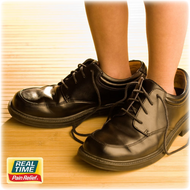9 Tips to Soothe Growing Pains
9th Nov 2022
If your child has issues with growing pains, it can be a trying situation. Pain can make it hard to sleep at night, and you will do whatever you can to relieve your child’s pain. Here are 9 tips to help you soothe your child’s growing pains.
What Are Growing Pains?
Growing pains tend to affect children between the ages of 3-5 and 8-12. Since they’re called “growing pains,” many people believe that it has some connection to childhood growth. However, a clear cause of growing pains has yet to be established. Most health experts believe that they stem from the soreness that comes from the everyday life of being an active child. The long days of running, jumping, and climbing can stress a little one’s body, which then manifests as soreness as your child relaxes.
Symptoms of Growing Pains
For most children, growing pains occur in the evening time and during sleep. But, usually, the pain is gone by the morning. The legs are the most commonly affected by growing pains. Your child may experience soreness in the thighs, calf muscles, and behind the knees.
9 Tips to Soothe Growing Pains
#1) Massage
Since the problem is with overworked and tired muscles, massaging the area in pain is one of the best treatment options. Gentle massage can work some of the tightness and soreness out of the muscles and help your child relax. Ask your child where the pain is and gently rub the entire muscle group for a few minutes.
#2) Stretching
Stretching can be one of the keys to relieving and preventing growing pains. Stretching before physical activity helps keep the muscles loose and ready for activity. Teach your children some stretches like toe touches, leg raises, and lunges. You can also encourage your child to perform some stretches before bedtime.
#3) Topical Pain Relief
A topical pain relief lotion can be great for a child who is suffering from growing pains. Topical pain relief lotions or creams can be applied directly to the area experiencing growing pains, and they can provide relief without worrying about the possible unwanted side effects of NSAIDs or acetaminophen. Look for pain relief lotions with lower concentrations of menthol (1.5% or less) to prevent an uncomfortable burning sensation that can occur with some brands of topical pain relief lotions.
#4) Heat Therapy
Since growing pains are primarily associated with sore muscles, heat therapy can be an effective treatment option. Heat can help to promote blood flow, soothe pain, and loosen up tight muscle contractions. You can apply a heating pad to the area in pain, or have your child take a warm bath or shower.
#5) Footwear
You also want to make sure that your child has good, supportive footwear. Shoes need to provide adequate support for the ankles and arches. If they lack this support, it can impact the way your child walks or runs, stressing the legs and contributing to growing pains.
#6) Vitamin D
Certain vitamin deficiencies can contribute to problems with growing pains. A 2015 study published in the journal, Medical Principals and Practice, showed that many children who deal with growing pains also have a vitamin D deficiency. They found that vitamin D supplements can be an effective remedy for reducing the severity of growing pains for these children.
#7) Hydration
Encourage your child to drink water before and after playing. As the body dehydrates, muscles are more susceptible to being tight and sore, which can lead to growing pains. If you notice that your child is sweating a lot, you can also offer them a low sugar electrolyte drink to help replenish their body’s electrolytes.
#8) Keep Them Active
If children don’t get regular exercise but then suddenly have an active day of playing or participating in a sport, they may deal with a round of growing pains.
Encourage your child to get regular activity, so that their muscles will be accustomed to a workload. This can help to make growing pains less frequent and less severe. If your child can’t get out on some days, consider teaching them some in-home exercises.
#9) Rest
After your child has been very active, they will more than likely need a day or two of rest from activity. Sometimes the body just needs time to rest and heal.
For over 20 years, families across the U.S. have turned to Real Time’s lotions and creams for PAIN RELIEF YOU CAN TRUST®. From Lifestyle Essentials, through our Nujuvena line, to Pain Relief Formulas, Real Time has you covered.





